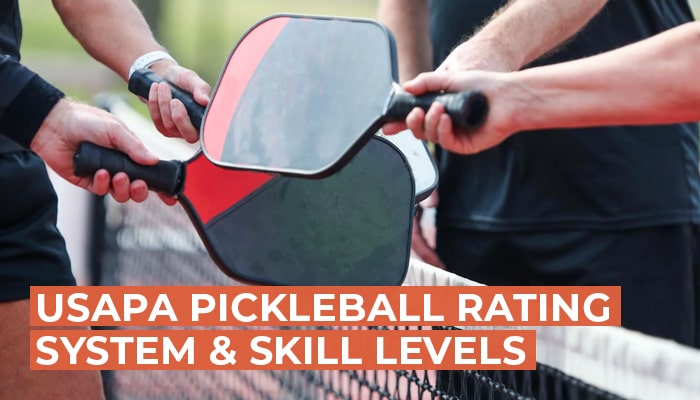If you’re on a pickleball court, chances are you’ve heard someone say that they’re rated 3.0 or 4.5, or maybe even 5.0. If you’re new to the sport, you may be wondering what all the numbers mean.
The pickleball rating system is easy to understand if you know a few basics about how the ratings are awarded and the differences between the pickleball skill levels. Here’s all you need to know about the pickleball rating system.
Pickleball Rating System
The USAPA Pickleball Rating System is based on each player’s skill level. Similar to tennis, the rating system also uses a mathematical formula to combine two players’ skill levels into a match rating.
USAPA’s Pickleball Rating System is an objective method of assessing and predicting the results of pickleball matches. The pickleball rating system was first developed by Monica Pattison and Tim Dalby in 2017 and was further refined for all levels by Jay Deming in 2018.
The rating system is designed to determine your level of playing ability so you are matched with players who have similar skills. The new pickleball rating system is based on a scale from 1.0 to 6.0, but only 2.5, 3.0, 3.5, 4.0, and 4.5 levels are used frequently.
If you are still wondering “what is a 3.5 or 3.0 rating in pickleball?”. I have answers to all your rating and skill level queries.
Pickleball Rating descriptions for your learning
The USAPA (USA Pickleball Association) has established these main rating categories for players:
2.0 Skill Level
At the lowest skill level, these players are just learning the game and play with an emphasis on getting the ball over the net and into play. Scoring is typically done by “side-out,” meaning that points can only be scored while serving. Players at this level are not expected to keep score, but rather to work on developing their games.
2.5 Skill Level:
Similar to 2.0, except that these players have a greater sense of how the game is played and how to move around the court. They may still make mistakes in terms of where to position themselves or when to hit certain shots, but they are more aware of what is going on around them during a match. This level uses side-out scoring as well, and most players will focus on hitting groundstrokes instead of volleys or serves.
3.0 Skill Level:
These players have developed a strong understanding of pickleball fundamentals and court positioning. Players are able to consistently execute deep dinks, blocks, drives, and lobs while under pressure. Though they still lack consistency and directional intent.
3.5 Skill Level:
These are generally intermediate pickleball players. At this skill level, players usually understand the differences between hard and soft game shorts. And they have the ability to move towards non-volley zones during the play.
4.0 Skill Level:
These players are more consistent in all game phases, and can successfully portend the shots of their opponents to position themselves correctly in court. 4.0 players are superior in terms of power, consistency, and speed. They can control the ball well.
4.5 Skill Level:
This skill rating ensures that players can execute different shots and strategies with more control and consistency. These players make fewer unforced errors. And 4.5 players can easily change their game strategy and plan according to the strengths and weaknesses of their opponents.
5.0 Skill Level:
The players have mastered all their backhand and forehand shots along with other key strategies. They have also mastered the rules of stacking and can attack opponents in an effective way.
5.5 and Above skill level
These are the players who are winning at the highest sports level consistently. They win mostly against other players of the same skill level at the tournament and individual levels.
Don’t forget to read my article on Pickleball pro players to learn more about pickleball skill levels and top pickleball players.
Pickleball Rating Guide – How to do skill assessment?
Pickleball has its own rating system, which helps players determine their skill level.
This allows players to play with others at the same level, which ensures enjoyable and competitive games. It also avoids frustrations for both new and experienced players.
Currently, there are more than 5000 licensed pickleball players in the U.S. However, not many of them know much about the rating system. So, there has been an increase in the number of people wanting to know how the pickleball rating system works.
This guide will help you understand what it is and how it works.
Before I dive into the details of the pickleball rating guide, you should know that there are two types of ratings:
Self-rating — a player can determine their own ability level and request a rating card from USA Pickleball Association (USAPA) after paying a fee (around $30).
Tournament rating — this is achieved by playing in USAPA tournaments, where each participant is assigned a skill level after that particular tournament ends.
◼ Pickleball Self Rating:
Based on the personal skill assessment, previous tournament results, and ability to play different shots, a player can rate his pickleball skill himself. But that doesn’t mean placing yourself on a skill level that is not fact-based or above your real capability.
Because in any tournament or organized match, your first game result is referenced as your skill level in pickleball.
The rating system is set up so that it takes approximately 20 games to move up or down one-half point in your rating unless the National Office determines otherwise through its pickleball self-rating procedure.
◾ UTPR (USAPA Tournament Player Rating)
UTPR, lately known as USAPA Pickleball Tournament Player Rating. This is a more systematic rating that ensures no player is playing down a skill level to win medals or prizes. And it is awarded to only tournament players. Therefore, it is assumed to be more valid and authentic than self-rating. Less frequent and recreational pickleball players usually don’t have any Tournament rating.
You can also improve your rating if you are awarded a “self-rating” by the USAPA National Office and/or pickleball state association officials. To qualify, you must play in tournaments and league events and achieve specific skill levels at each level before advancing to the next higher level.

A Word From The Expert Pickleball Player – Conclusion
The last thing I will mention is that the rating system is not perfect, but it’s the best we currently have available. There are many different ways to determine a player’s skill level. In general, it is based on experience, and how they play against other players.
You can improve your rating by winning matches against higher-rated opponents in sanctioned tournaments or league play (tournament play has priority).
So put on the seat belt and get ready for the crusade!

